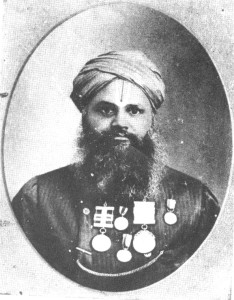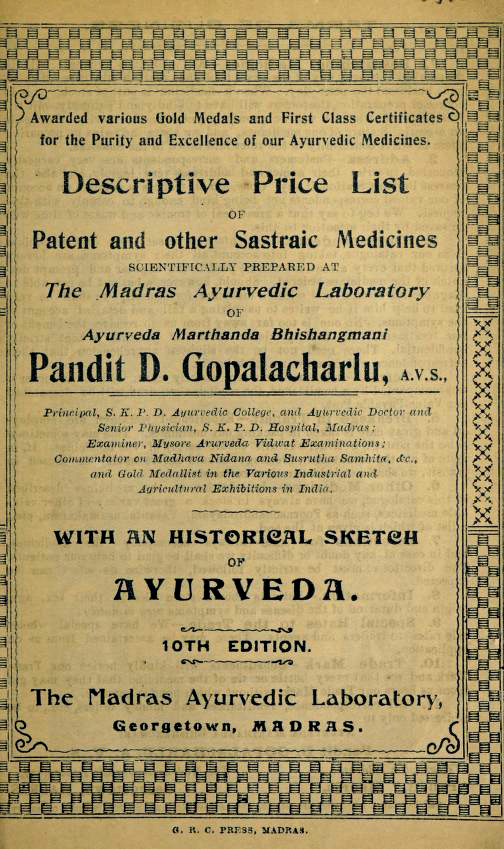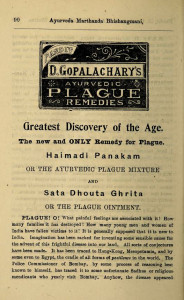Registered with the Registrar of Newspapers for India under R.N.I 53640/91
Vol. XXIX No. 7, July 16-31, 2019
Lost Landmarks of Chennai
Sriram V
The first Ayurveda Hospital in Madras
The history of most of the famous hospitals of the city that follow the allopathic discipline is well documented. But what of the institutions that provided healthcare the Indian way through the three principal streams of Ayurveda, Siddha and Unani? Not much is known about these and their histories can only be reconstructed through scattered references. One among such hospitals was the Sri Kanyaka Parameswari Devasthana Dharma Ayurveda Vaidyashala. It functioned in the first decades of the 20th century and faded away thereafter, though it did leave behind some very famous successor institutions in its wake.
It was, as the name suggests, a charitable Ayurvedic hospital, more of dispensary, attached to the Sri Kanyaka Parameswari Devasthanam (SKPD) located in the Kothwal Chawadi area of George Town. As per the reminiscences of Dr. K.N. Kesari, the well-known Ayurvedic practitioner of later years, this was begun by the priests of the temple together with Paluri Rajan Chetty, a prominent businessman of the Arya Vaisya community. Further details are available in a pamphlet that the hospital published in 1908 as per which the institution came into existence on August 14, 1898 and in the first year attended to 14,731 patients, the number increasing to a record 69,000 by the end of the first decade.

Pt. D. Gopalacharyulu – from the autobiography of Dr. A. Lakshmipathy, courtesy: Rukmini Amirapu.
The man behind the success of the free hospital was its head – Pundit D. Gopalacharyulu (also spelt as Gopalacharlu). In a biographical note he gives in the same pamphlet cited above, he states that he came from a family that was traditionally into the practise of Ayurveda. But as he grew up, he desired to present the science in a more systematic way just as western medicine was, and so enrolled himself at the Mysore Maharajah’s Sanskrit College and after graduating, went on an all India tour to familiarise himself with Ayurvedic practices elsewhere. He later worked at a dispensary in Bangalore where his formulations were successful. In 1901, he joined the SKPD’s Free Hospital in Madras.
Once appointed, he brought in considerable changes to the functioning of the place. Realising that institutions like the General Hospital have a Medical College as an adjunct, he together with the hospital committee set up an Ayurvedic College in which students were trained in Hindu Medical Science. While Sanskrit texts were taught by Gopalacharyulu and his assistants, he also ensured that modern concepts such as hygiene were imparted by doctors trained in the allopathic stream. The prequalification to gain admission was a working knowledge of Sanskrit and the student had to be below 25 years of age. The graduate degree was Vidvat and there was a post-Vidvat course as well. The annual examinations happened in December, with professors from other parts of India conducting them. The graduates were termed Proficients as was the case with the University of Madras.
The SKPD instituted scholarships of Rs 10 per month for seven students and Pt Gopalacharyulu supplemented this with ten scholarships from his private funds. The money came from his Ayurvedic Laboratory, which he set up in his personal capacity at Acharappan Street, George Town, and which soon became a great success, in particular for its plague cure. There were besides, medicines for a whole host of ailments such as diabetes, asthma, anaemia, biliousness, loss of hair, leprosy, constipation and nervous debilities apart from oils that could be applied as unguents and used for massages. These were sold all over India and soon the Pundit began receiving several testimonials all of which he put to good use as advertisements. Several titles were conferred on him and he prefixed them all to his name, his letterheads referring to him as Ayurveda Marthanda Bhishangamani Pandit D Gopalacharlu. He participated in All India Ayurvedic Conferences. At the Calcutta Industrial and Agricultural Exhibition of 1906, he was awarded a gold medal.
Some of the testimonials given in the 1908 pamphlet carry references to the way the hospital was laid out. There were evidently no in-patients. Those that came were segregated by sex and Pt Gopalacharyulu and two assistants attended to them. The storeroom where medicines were kept was evidently the place that most visitors were taken to for they all write in its praise, in particular the way in which all stock was neatly stored and labelled. There was one complaint that the room was too small for a hospital that catered to more than 200 patients in a day. An interesting testimonial is one of 1904 from V Krishnaswami Iyer, the famed Vakil who would later become Judge of the High Court of Madras and still later Member of the Governor’s Executive Council. He writes that the concept of an Ayurvedic hospital is worthy of encouragement and more should come up soon. Was this therefore the inspiration behind his setting up the Venkataramana Ayurveda Dispensary in Mylapore a year later?
Early in his tenure at the SKPD, Pt. Gopalacharyulu was introduced to KN Kesari, and the latter became his assistant. Though younger by a few years to the Pundit, Kesari had had a longer tenure in Madras, having run away to the city in 1888 when he was just 13. He was thus of immense help to Gopalacharyulu, finding him a place to stay and also getting some of the Chettys to loan the Pundit some money. From Kesari’s writings we get to know that the SKPD Hospital was in Godown Street.

|

|
|
A Madras Ayurvedic Laboratory pamphlet, 1908. |
|
It was the Ayurvedic Plague Mixture that Gopalacharyulu developed, which caused trouble between him and Kesari, after they had worked together for four years very closely. Realising that Bangalore was having one of its frequent plague epidemics, Gopalacharyulu desired that his medication be marketed there. But he was hesitant as he was not familiar with English. Kesari did the selling and when money began coming in, was shocked to find he was to get nothing for his efforts. He resigned and opted to start on his own, founding his Kesari Kuteeram thereafter.
But there was no stopping Gopalacharyulu. The sale of his medicines and the success of the Ayurvedic College, where students from various parts of India had begun to join and study, had made him a celebrity. When the SKPD decided for reasons unknown to close down the college, he opted to take it over in his personal capacity and run it. Several prominent allopathic practitioners of the city had come to see the merits in his formulations and medications and were his ardent supporters. Chief among these was Dr A Lakshmipathy, a qualified eye surgeon from the Madras Medical College who became lecturer at the Ayurvedic College, teaching the subjects of Anatomy and Surgery from 1914. The two attended several Ayurvedic conferences, and protested vehemently when the Madras Government mulled over abolishing the practice of Ayurveda on the grounds that it was unscientific. Lakshmipathy also became a student of Pt Gopalacharyulu, studying Ayurveda under him for five years. Thus when the latter suddenly died in September 1920, it was but natural for the former to take on the running of the Ayurvedic College and the Laboratory.
(To be concluded next fortnight)
The author thanks Karthik Bhatt for providing the 1908 pamphlet on the dispensary.


Thank you for bringing out the historical facts. There was those who performed yeoman service and ensured that the heritage and advancements in the field of native medicine gained over centuries, were not only preserved but also scientifically taken forward through new formulations, cure for the deadly Plague etc. Spreading the knowledge through a college and scholarships to support, were indeed laudable. Salutations and tributes to these men of achievement.